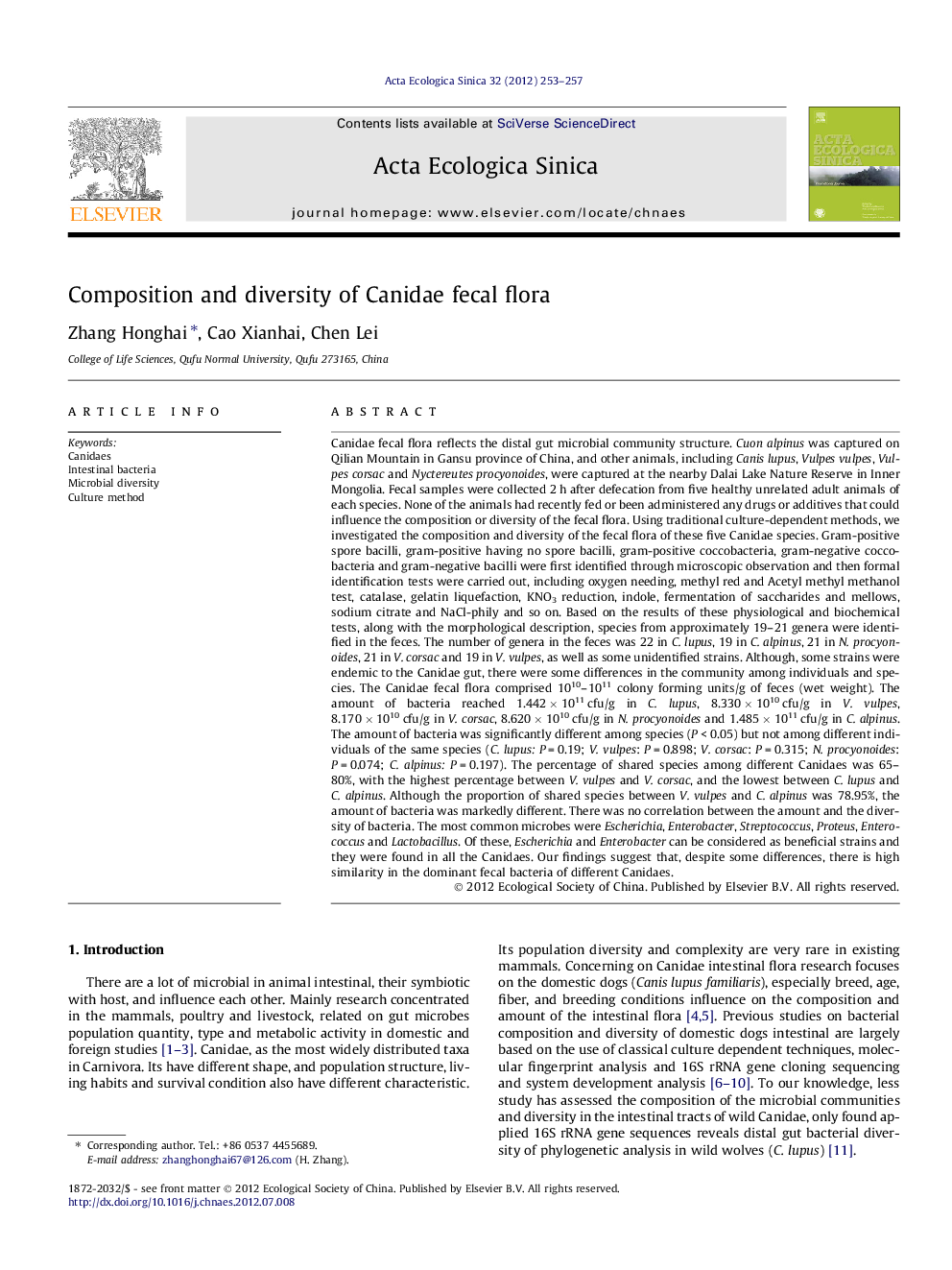| Article ID | Journal | Published Year | Pages | File Type |
|---|---|---|---|---|
| 4380048 | Acta Ecologica Sinica | 2012 | 5 Pages |
Abstract
Canidae fecal flora reflects the distal gut microbial community structure. Cuon alpinus was captured on Qilian Mountain in Gansu province of China, and other animals, including Canis lupus, Vulpes vulpes, Vulpes corsac and Nyctereutes procyonoides, were captured at the nearby Dalai Lake Nature Reserve in Inner Mongolia. Fecal samples were collected 2Â h after defecation from five healthy unrelated adult animals of each species. None of the animals had recently fed or been administered any drugs or additives that could influence the composition or diversity of the fecal flora. Using traditional culture-dependent methods, we investigated the composition and diversity of the fecal flora of these five Canidae species. Gram-positive spore bacilli, gram-positive having no spore bacilli, gram-positive coccobacteria, gram-negative coccobacteria and gram-negative bacilli were first identified through microscopic observation and then formal identification tests were carried out, including oxygen needing, methyl red and Acetyl methyl methanol test, catalase, gelatin liquefaction, KNO3 reduction, indole, fermentation of saccharides and mellows, sodium citrate and NaCl-phily and so on. Based on the results of these physiological and biochemical tests, along with the morphological description, species from approximately 19-21 genera were identified in the feces. The number of genera in the feces was 22 in C. lupus, 19 in C. alpinus, 21 in N. procyonoides, 21 in V. corsac and 19 in V. vulpes, as well as some unidentified strains. Although, some strains were endemic to the Canidae gut, there were some differences in the community among individuals and species. The Canidae fecal flora comprised 1010-1011 colony forming units/g of feces (wet weight). The amount of bacteria reached 1.442Â ÃÂ 1011Â cfu/g in C. lupus, 8.330Â ÃÂ 1010Â cfu/g in V. vulpes, 8.170Â ÃÂ 1010Â cfu/g in V. corsac, 8.620Â ÃÂ 1010Â cfu/g in N. procyonoides and 1.485Â ÃÂ 1011Â cfu/g in C. alpinus. The amount of bacteria was significantly different among species (PÂ <Â 0.05) but not among different individuals of the same species (C. lupus: PÂ =Â 0.19; V. vulpes: PÂ =Â 0.898; V. corsac: PÂ =Â 0.315; N. procyonoides: PÂ =Â 0.074; C. alpinus: PÂ =Â 0.197). The percentage of shared species among different Canidaes was 65-80%, with the highest percentage between V. vulpes and V. corsac, and the lowest between C. lupus and C. alpinus. Although the proportion of shared species between V. vulpes and C. alpinus was 78.95%, the amount of bacteria was markedly different. There was no correlation between the amount and the diversity of bacteria. The most common microbes were Escherichia, Enterobacter, Streptococcus, Proteus, Enterococcus and Lactobacillus. Of these, Escherichia and Enterobacter can be considered as beneficial strains and they were found in all the Canidaes. Our findings suggest that, despite some differences, there is high similarity in the dominant fecal bacteria of different Canidaes.
Related Topics
Life Sciences
Agricultural and Biological Sciences
Ecology, Evolution, Behavior and Systematics
Authors
Zhang Honghai, Cao Xianhai, Chen Lei,
